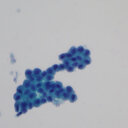Detection of hydrogen cyanide from oral anaerobes by cavity ring down spectroscopy.
Atslēgvārdi
Abstrakts
Hydrogen cyanide (HCN) has been recognized as a potential biomarker for non-invasive diagnosis of Pseudomonas aeruginosa infection in the lung. However, the oral cavity is a dominant production site for exhaled HCN and this contribution can mask the HCN generated in the lung. It is thus important to understand the sources of HCN production in the oral cavity. By screening of oral anaerobes for HCN production, we observed that the genus of Porphyromonas, Prevotella and Fusobacterium generated low levels of HCN in vitro. This is the first study to show that oral anaerobes are capable of producing HCN in vitro. Further investigations were conducted on the species of P. gingivalis and we successfully detected HCN production (0.9-10.9 ppb) in the headspace of three P. gingivalis reference strains (ATCC 33277, W50 and OMG 434) and one clinical isolate. From P. gingivalis ATCC 33277 and W50, a strong correlation between HCN and CO2 concentrations (rs = 0.89, p < 0.001) was observed, indicating that the HCN production of P. gingivalis might be connected with the bacterial metabolic activity. These results indicate that our setup could be widely applied to the screening of in vitro HCN production by both aerobic and anaerobic bacteria.


